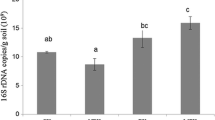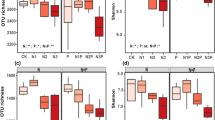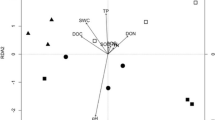Abstract
The changes of soil bacterial biomass and community composition were monitored in a simulated nitrogen (N) deposition experiment during 4 years of Cunninghamia lanceolata growth in a plantation site in southern China. The experimental design included two N forms (NH4Cl and KNO3) and five levels of N deposition (0, 20, 40, 60, 80 kg N ha−1) for 2 years. Research into the bacterial population was conducted using plate count, phospholipid fatty acid (PLFA) composition, and 16Sr DNA gene-based high-throughput pyrosequencing methods. The results of plate count and PLFA analysis indicated that ammonium (NH4 +) addition increased bacterial number and biomass, whereas nitrate (NO3 −) addition decreased these values. The high-throughput sequencing showed that N deposition of the two N forms inhibited the growth of bacteria compared with control plots, and the changing trend was related to the NH4 +-N/NO3 −-N ratio of soil. When the N deposition dose exceeded 20 kg N ha−1, there was a significant effect on cultured bacteria counts and bacterial biomass. When examining the bacterial community, we observed 22 bacterial phyla of which Proteobacteria, Acidobacteria, and Actinobacteria were dominant. Acidobacteria abundance was higher in NH4 + treatments than NO3 − treatments. When the rates of NH4 + deposition increased, Acidobacteria abundance decreased; however, it showed a positive correlation in NO3 − treatments. The bacterial cluster structures were significantly different between different N addition rates in the NO3 −-treated plots. This research will provide data support to addressing the negative influences of nitrogen deposition and provide reference for soil management.




Similar content being viewed by others
References
Aber, J., McDowell, W., Nadelhoffer, K., Magill, A., Berntson, G., Kamakea, M., & Fernandez, I. (1998). Nitrogen saturation in temperate forest ecosystems. BioScience, 48(11), 921–934.
Aber, J. D., Goodale, C. L., Ollinger, S. V., Smith, M. L., Magill, A. H., Martin, M. E., & Stoddard, J. L. (2003). Is nitrogen deposition altering the nitrogen status of northeastern forests? BioScience, 53(4), 375–389.
Aerts, R., & Bobbink, R. (1999). The impact of atmospheric nitrogen deposition on vegetation processes in terrestrial, non-forest ecosystems. In The impact of nitrogen deposition on natural and semi-natural ecosystems (pp. 85–122). Netherlands: Springer.
Arnebrant, K., Bååth, E., Söderström, B., & Nohrstedt, H. Ö. (1996). Soil microbial activity in eleven Swedish coniferous forests in relation to site fertility and nitrogen fertilization. Scandinavian Journal of Forest Research, 11(1–4), 1–6.
Bååth, E., & Anderson, T. H. (2003). Comparison of soil fungal/bacterial ratios in a pH gradient using physiological and PLFA-based techniques. Soil Biology and Biochemistry, 35(7), 955–963.
Bachar, A., Al-Ashhab, A., Soares, M. I., Sklarz, M. Y., Angel, R., Ungar, E. D., & Gillor, O. (2010). Soil microbial abundance and diversity along a low precipitation gradient. Microbial Ecology, 60(2), 453–461.
Bardgett, R. D., Freeman, C., & Ostle, N. J. (2008). Microbial contributions to climate change through carbon cycle feedbacks. The ISME Journal, 2(8), 805–814.
Biederbeck, V. O., Curtin, D., Bouman, O. T., Campbell, C. A., & Ukrainetz, H. (1996). Soil microbial and biochemical properties after ten years of fertilization with urea and anhydrous ammonia. Canadian Journal of Soil Science, 76(1), 7–14.
Chaudhry, V., Rehman, A., Mishra, A., Chauhan, P. S., & Nautiyal, C. S. (2012). Changes in bacterial community structure of agricultural land due to long-term organic and chemical amendments. Microbial Ecology, 64(2), 450–460.
Chen, X. Y., Mulder, J., Wang, Y. H., Zhao, D. W., & Xiang, R. J. (2004). Atmospheric deposition, mineralization and leaching of nitrogen in subtropical forested catchments, South China. Environmental Geochemistry and Health, 26(2), 179–186.
Covaleda, S., Pajares, S., Gallardo, J. F., Padilla, J., Báez, A., & Etchevers, J. D. (2009). Effect of different agricultural management systems on chemical fertility in cultivated tepetates of the Mexican trans-volcanic belt. Agriculture, Ecosystems & Environment, 129(4), 422–427.
DeForest, J. L., Zak, D. R., Pregitzer, K. S., & Burton, A. J. (2004). Atmospheric nitrate deposition and the microbial degradation of cellobiose and vanillin in a northern hardwood forest. Soil Biology and Biochemistry, 36(6), 965–971.
Di Bella, J. M., Bao, Y., Gloor, G. B., et al. (2013). High throughput sequencing methods and analysis for microbiome research[J]. Journal of Microbiological Methods, 95(3), 401–414.
Fierer, N., & Jackson, R. B. (2006). The diversity and biogeography of soil bacterial communities. Proceedings of the National Academy of Sciences of the United States of America, 103(3), 626–631.
Fierer, N., Morse, J. L., Berthrong, S. T., Bernhardt, E. S., & Jackson, R. B. (2007). Environmental controls on the landscape-scale biogeography of stream bacterial communities. Ecology, 88(9), 2162–2173.
Frey, S. D., Knorr, M., Parrent, J. L., & Simpson, R. T. (2004). Chronic nitrogen enrichment affects the structure and function of the soil microbial community in temperate hardwood and pine forests. Forest Ecology and Management, 196(1), 159–171.
Gallo, M., Amonette, R., Lauber, C., Sinsabaugh, R. L., & Zak, D. R. (2004). Microbial community structure and oxidative enzyme activity in nitrogen-amended north temperate forest soils. Microbial Ecology, 48(2), 218–229.
Galloway, J. N., Townsend, A. R., Erisman, J. W., Bekunda, M., Cai, Z., Freney, J. R., & Sutton, M. A. (2008). Transformation of the nitrogen cycle: recent trends, questions, and potential solutions. Science, 320(5878), 889–892.
Gensberger, E. T., Gössl, E. M., Antonielli, L., et al. (2015). Effect of different heterotrophic plate count methods on the estimation of the composition of the culturable microbial community. Peer Journal, 3, e862.
Gremion, F., Chatzinotas, A., & Harms, H. (2003). Comparative 16S rDNA and 16S rRNA sequence analysis indicates that Actinobacteria might be a dominant part of the metabolically active bacteria in heavy metal-contaminated bulk and rhizosphere soil. Environmental Microbiology, 5(10), 896–907.
Hackl, E., Zechmeister-Boltenstern, S., Bodrossy, L., & Sessitsch, A. (2004). Comparison of diversities and compositions of bacterial populations inhabiting natural forest soils. Applied and Environmental Microbiology, 70(9), 5057–5065.
Jangid, K., Williams, M. A., Franzluebbers, A. J., Sanderlin, J. S., Reeves, J. H., Jenkins, M. B., & Whitman, W. B. (2008). Relative impacts of land-use, management intensity and fertilization upon soil microbial community structure in agricultural systems. Soil Biology and Biochemistry, 40(11), 2843–2853.
Janssen, P. H. (2006). Identifying the dominant soil bacterial taxa in libraries of 16SrRNA and 16SrRNA genes. Applied and Environmental Microbiology, 72(3), 1719–1728.
Ju, X., Liu, X., Zhang, F., & Roelcke, M. (2004). Nitrogen fertilization, soil nitrate accumulation, and policy recommendations in several agricultural regions of China. AMBIO: A Journal of the Human Environment, 33(6), 300–305.
Kauppi, S., Romantschuk, M., Strömmer, R., et al. (2012). Natural attenuation is enhanced in previously contaminated and coniferous forest soils. Environmental Science and Pollution Research, 19(1), 53–63.
Kim, H., & Kang, H. (2011). The impacts of excessive nitrogen additions on enzyme activities and nutrient leaching in two contrasting forest soils. The Journal of Microbiology, 49(3), 369–375.
Kopecky, J., Kyselkova, M., Omelka, M., Cermak, L., Novotna, J., Grundmann, G. L., & Sagova-Mareckova, M. (2011). Actinobacterial community dominated by a distinct clade in acidic soil of a waterlogged deciduous forest. FEMS Microbiology Ecology, 78(2), 386–394.
Koyama, A., Wallenstein, M. D., Simpson, R. T., & Moore, J. C. (2013). Soil bacterial community composition altered by increased nutrient availability in Arctic tundra soils. Frontiers in Microbiology, 5, 516.
LaPara, T. M., Nakatsu, C. H., Pantea, L., & Alleman, J. E. (2000). Phylogenetic analysis of bacterial communities in mesophilic and thermophilic bioreactors treating pharmaceutical wastewater. Applied and Environmental Microbiology, 66(9), 3951–3959.
Lauber, C. L., Hamady, M., Knight, R., & Fierer, N. (2009). Pyrosequencing-based assessment of soil pH as a predictor of soil bacterial community structure at the continental scale. Applied and Environmental Microbiology, 75(15), 5111–5120.
Liu, X., Duan, L., Mo, J., Du, E., Shen, J., Lu, X., & Zhang, F. (2011). Nitrogen deposition and its ecological impact in China: an overview. Environmental Pollution, 159(10), 2251–2264.
Liu, X., Zhang, Y., Han, W., Tang, A., Shen, J., Cui, Z., & Zhang, F. (2013). Enhanced nitrogen deposition over China. Nature, 494(7438), 459–462.
Lombao, A., Martín, A., Barreiro, A., et al. (2013). Microbial biomass estimated by phospholipid fatty acids (PLFA pattern) in a soil with different post-fire treatments (seeding, mulching) one year after the experimental fire. Flamma, 4(1), 9–12.
Lu, X. K., Mo, J. M., & Dong, S. (2008). Effects of nitrogen deposition on forest biodiversity. Acta Ecologica Sinica, 28(11), 5532–5548.
Männistö, M. K., Tiirola, M., & Häggblom, M. M. (2007). Bacterial communities in Arctic fields of Finnish Lapland are stable but highly pH-dependent. FEMS Microbiology Ecology, 59(2), 452–465.
Mo, J. M., Brown, S., Xue, J., Fang, Y. T., Li, Z., Li, D., & Dong, S. (2007). Response of nutrient dynamics of decomposing pine (Pinus massoniana) needles to simulated N deposition in a disturbed and a rehabilitated forest in tropical China. Ecological Research, 22(4), 649–658.
Myers, R. T., Zak, D. R., White, D. C., & Peacock, A. (2001). Landscape-level patterns of microbial community composition and substrate use in upland forest ecosystems. Soil Science Society of America Journal, 65(2), 359–367.
Nacke, H., Thürmer, A., Wollherr, A., Will, C., Hodac, L., Herold, N., & Daniel, R. (2011). Pyrosequencing-based assessment of bacterial community structure along different management types in German forest and grassland soils. PloS One, 6(2), e17000.
Quaiser, A., Ochsenreiter, T., Lanz, C., Schuster, S. C., Treusch, A. H., Eck, J., et al. (2003). Acidobacteria form a coherent but highly diverse group within the bacterial domain: evidence from environmental genomics. Molecular Microbiology, 50(2), 563–575.
Ramirez, K. S., Craine, J. M., & Fierer, N. (2012). Consistent effects of nitrogen amendments on soil microbial communities and processes across biomes. Global Change Biology, 18(6), 1918–1927.
Richter, D. D., Markewitz, D., Heine, P. R., Jin, V., Raikes, J., Tian, K., & Wells, C. G. (2000). Legacies of agriculture and forest regrowth in the nitrogen of old-field soils. Forest Ecology and Management, 138(1), 233–248.
Sala, O. E., Chapin, F. S., Armesto, J. J., Berlow, E., Bloomfield, J., Dirzo, R., & Wall, D. H. (2000). Global biodiversity scenarios for the year 2100. Science, 287(5459), 1770–1774.
Schloss, P. D., Westcott, S. L., Ryabin, T., Hall, J. R., Hartmann, M., Hollister, E. B., & Weber, C. F. (2009). Introducing mothur: open-source, platform-independent, community-supported software for describing and comparing microbial communities. Applied and Environmental Microbiology, 75(23), 7537–7541.
Shange, R. S., Ankumah, R. O., Ibekwe, A. M., Zabawa, R., & Dowd, S. E. (2012). Distinct soil bacterial communities revealed under a diversely managed agroecosystem. PLoS One, 7(7), e40338.
Shapleigh, J. P. (2011). Oxygen control of nitrogen oxide respiration, focusing on α-proteobacteria. Biochemical Society Transactions, 39(1), 179–183.
Smit, E., Leeflang, P., Gommans, S., Broek, J., Mil, S., & Wernars, K. (2001). Diversity and seasonal fluctuations of the dominant members of the bacterial soil community in a wheat field as determined by cultivation and molecular methods. Applied and Environmental Microbiology, 67(5), 2284–2291.
Song, M., Jing, S., Zhou, Y., et al. (2015). Dynamics of soil nematode communities in wheat fields under different nitrogen management in Northern China Plain. European Journal of Soil Biology, 71, 13–20.
Treseder, K. K. (2008). Nitrogen additions and microbial biomass: a meta-analysis of ecosystem studies. Ecology Letters, 11(10), 1111–1120.
VanInsberghe, D., Hartmann, M., Stewart, G. R., et al. (2013). Isolation of a substantial proportion of forest soil bacterial communities detected via pyrotag sequencing. Applied and Environmental Microbiology, 79(6), 2096–2098.
Waldrop, M. P., Zak, D. R., & Sinsabaugh, R. L. (2004). Microbial community response to nitrogen deposition in northern forest ecosystems. Soil Biology and Biochemistry, 36(9), 1443–1451.
Wang, C. T., Wang, G. X., Yong, W., Rashid, R., Li, M., Lei, H., & Luo, Y. Q. (2015). Urea addition and litter manipulation alter plant community and soil microbial community composition in a Kobresia humilis meadow. European Journal of Soil Biology, 70, 7–14.
Xue, C., & Othmer, H. G. (2009). Multiscale models of taxis-driven patterning in bacterial populations. SIAM Journal on Applied Mathematics, 70(1), 133–167.
Youssef, N. H., & Elshahed, M. S. (2009). Diversity rankings among bacterial lineages in soil. The ISME Journal, 3(3), 305–313.
Zelles, L. (1999). Fatty acid patterns of phospholipids and lipopolysaccharides in the characterisation of microbial communities in soil: a review. Biology and Fertility of Soils, 29(2), 111–129.
Zhan, X., Yu, G., He, N., et al. (2014). Nitrogen deposition and its spatial pattern in main forest ecosystems along north–south transect of eastern China. Chinese Geographical Science, 24(2), 137–146.
Acknowledgments
This study was supported in part by [1] National Key Research Program of China (No.2016YFD0600302) and [2] Research Institute of Forestry, the Chinese Academy of Forestry (No.CAFYBB2012026).
Author information
Authors and Affiliations
Corresponding author
Ethics declarations
Conflict of Interest
The authors declare that they have no conflict of interest.
Rights and permissions
About this article
Cite this article
Liu, C., Dong, Y., Sun, Q. et al. Soil Bacterial Community Response to Short-Term Manipulation of the Nitrogen Deposition Form and Dose in a Chinese Fir Plantation in Southern China. Water Air Soil Pollut 227, 447 (2016). https://doi.org/10.1007/s11270-016-3152-0
Received:
Accepted:
Published:
DOI: https://doi.org/10.1007/s11270-016-3152-0




